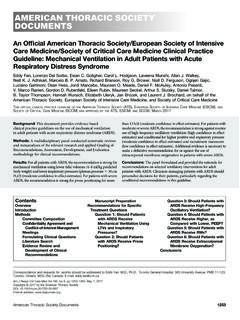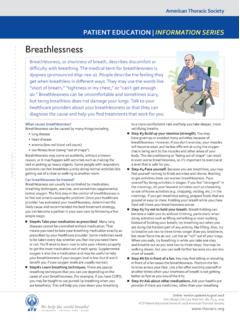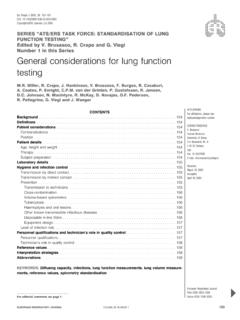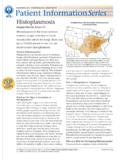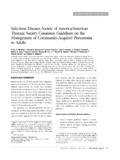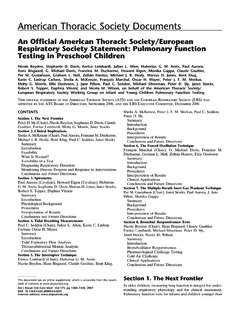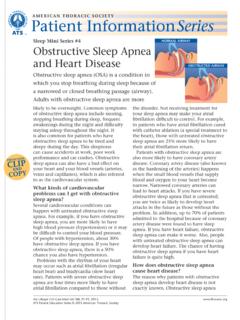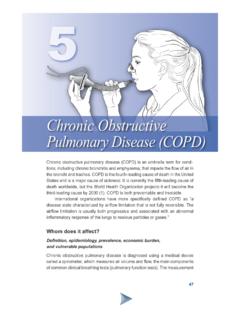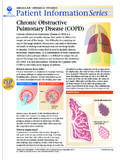Transcription of Clinical Utility - American Thoracic Society Documents
1 American Thoracic Society DocumentsAn Official American Thoracic Society Clinical PracticeGuideline: The Clinical Utility of Bronchoalveolar LavageCellular Analysis in Interstitial Lung DiseaseKeith C. Meyer, Ganesh Raghu, Robert P. Baughman, Kevin K. Brown, Ulrich Costabel, Roland M. du Bois,Marjolein Drent, Patricia L. Haslam, Dong Soon Kim, Sonoko Nagai, Paola Rottoli, Cesare Saltini,Moise s Selman, Charlie Strange, and Brent Wood, on behalf of the American Thoracic SocietyCommittee on BAL in Interstitial Lung DiseaseTHISOFFICIALCLINICALPRACTICEGUIDE LINE OF THEAMERICANTHORACICSOCIETY(ATS)WASAPPROV ED BY THEATS BOARD OFDIRECTORS,JANUARY2012 CONTENTSE xecutive SummaryIntroductionMethodsBAL Cellular Analyses as a Diagnostic Intervention for Patientswith Suspected ILD in the Era of HRCT ImagingPerforming, Handling, and Processing BALPre-Procedure PreparationThe BAL ProcedureHandling of the BAL FluidProcessingBAL Cellular Analysis in the Diagnosis of Specific ILDT echnique of BAL Cell AnalysesInterpretation of BAL Differential Cell CountsConclusions and future directionsBackground.
2 The Clinical Utility of bronchoalveolar lavage fluid(BAL) cell analysis for the diagnosis and management of patientswith interstitial lung disease (ILD) has been a subject of debate andcontroversy. The American Thoracic Society (ATS) sponsored a com-mittee of international experts to examine all relevant literature onBAL in ILD and provide recommendations concerning the use of BALin the diagnosis and management of patients with suspected : To provide recommendations for (1) the performance and pro-cessing of BAL and (2) the interpretation of BAL nucleated immune cellpatterns and other BAL characteristics in patients with suspected : A pragmatic systematic review was performed to identifyunique citations related to BAL in patients with ILD that were pub-lished between 1970 and 2006.
3 The search was updated during theguideline development process to include published literaturethrough March 2011. This is the evidence upon which the commit-tee s conclusions and recommendations are : Recommendations for the performance and processing ofBAL, as well as the interpretation of BAL findings, were formulatedby the :Whenusedinconjunctionwith comprehensive clinicalinformation and adequate Thoracic imaging such as high-resolutioncomputed tomography of the thorax, BAL cell patterns and other char-acteristics frequently provide useful information for the diagnosticevaluation of patients with suspected :bronchoscopy; bronchoalveolar lavage; lung diseases; in-terstitial lung disease.
4 Cell differential countEXECUTIVE SUMMARYIn patients with interstitial lung disease (ILD), accurate interpre-tation of bronchoalveolar lavage (BAL) cellular analyses requiresthat the BAL be performed correctly and that the BAL fluid behandled and processed properly. Because there is a paucity of ev-idence from controlled Clinical trials related to these steps and theclinical Utility of BAL cellular analysis, the recommendations pro-vided were informed largely by observational studies and the un-systematic observations of experts in the fields of BAL and ILD. Itis our hope that these guidelines will increase the Utility of BAL inthe diagnostic evaluation of ILD and promote the use of BAL inclinical studies and trials of ILD so that future guidelines may bebased upon higher quality the online supplement to these guidelines, we describeeach of the following in detail: the technique for performingBAL; specimen handling, transport, and processing; gross anal-ysis and differential cellular analysis; infection screening; flowcytometry; and using the BAL cellular findings narrow the dif-ferential diagnosis of Conclusions1.
5 Following the initial Clinical and radiographic evaluation ofpatients presenting with suspected ILD, BAL cellular analy-sis may be a useful adjunct in the diagnostic evaluation ofindividuals who lack a confident usual interstitial pneumonia(UIP) pattern on high-resolution computed tomography(HRCT) imaging of the thorax. Important considerationsabout whether to perform a BAL include the degree of un-certainty about the type of ILD, the likelihood that the BALwill provide helpful information, the patient s cardiopulmo-nary stability, the presence or absence of a bleeding diathesis,and the patient s values and Recognition of a predominantly inflammatory cellularpattern (increased lymphocytes, eosinophils, or neutro-phils)
6 In the BAL differential cell profile frequently helpsthe clinician narrow the differential diagnosis of ILD,even though such patterns are A normal BAL differential cell profile does not excludemicroscopic abnormalities in the lung article has an online supplement, which is accessible from this issue s table ofcontents at J Respir Crit Care Med Vol 185, Iss. 9, pp 1004 1014, May 1, 2012 Copyright 2012 by the American Thoracic SocietyDOI: address: BAL cellular analysis alone is insufficient to diagnose thespecific type of ILD, except in malignancies and some rareILDs. However, abnormal findings may support a specificdiagnosis when considered in the context of the Clinical andradiographic BAL cellular analysis has no firmly established prognosticvalue and cannot predict the response to Recommendations1.
7 For patients with suspected ILD in whom it has beendecided that a BAL can be tolerated and will be per-formed, we suggest that the BAL target site be chosenon the basis of an HRCT performed before the proce-dure, rather than choosing a traditional BAL site ( , theright middle lobe or lingula). In our Clinical practices, weperform the HRCT within 6 weeks of the For patients with suspected ILD who undergo BAL, werecommend that a differential cell count be performed onthe BAL fluid. This includes macrophage, lymphocyte,neutrophil, and eosinophil cell counts. The remainingsample may be used for microbiology, virology, and/ormalignant cell cytology laboratory testing if For patients with suspected ILD in whom BAL is per-formed, we suggest that lymphocyte subset analysis NOTbe a routine component of BAL cellular Summary of the Procedure, Transport, Processing,and Analysis1.
8 BAL is performed with the fiberoptic bronchoscope ina wedge position within the selected bronchopulmonarysegment. The total instilled volume of normal salineshould be no less than 100 ml and should not exceed300 ml. Three to five sequentially instilled aliquots aregenerally withdrawn after each aliquot For optimal sampling of distal airspaces, the total volume(pooled aliquots) retrieved should be greater than orequal to 30% of the total instilled volume. A total volumeof retrieved fluid less than 30% may provide a misleading-cell differential, especially if total retrieved volume is lessthan 10% of total instilled volume. If less than 5% of eachinstilled aliquot volume is recovered during the proceduredue to retention of most of the fluid in the lavaged seg-ment, the procedure should be aborted to avoid increasedrisk of tissue disruption and/or inflammatory mediatorrelease due to overdistention of the lavaged A minimal volume of 5 ml of a pooled BAL sample is neededfor BAL cellular analysis.
9 The optimal volume is 10 to 20 is acceptable to pool all aliquots of the retrieved BAL fluidfor routine analyses (including the first retrieved aliquot).4. BAL cell differential counts with greater than 15% lym-phocytes, greater than 3% neutrophils, greater than 1%eosinophils, and greater than mast cells representa lymphocytic cellular pattern, neutrophilic cellular pattern,eosinophilic cellular pattern, and mastocytosis, respec-tively. Each has diagnostic implications, as describedwithin the Table A predominance of macrophages containing smoking-related inclusions with no or minor increases in other celltypes is compatible with smoking-related ILD such asdesquamative interstitial pneumonia (DIP), respiratorybronchiolitis interstitial lung disease (RBILD), andLangerhans cell and chronic bilateral parenchymal infiltrative lung dis-eases with variable degrees of tissue inflammation and fibrosisare collectively referred to as interstitial lung diseases (ILDs)when they occur in immunocompetent hosts without infectionor neoplasm (1).
10 ILDs are generally characterized clinicallyby exertional dyspnea, bilateral pulmonary infiltrates on tho-racic imaging, abnormal pulmonary physiology, and abnormalgas transfer, while they are usually characterized pathologicallyby an accumulation of inflammatory and immune effector cellsthat is often accompanied by abnormal extracellular matrix inthe distal airways, alveolar walls, and interstitium. The ILDsusually evolve over months to years and include disorders ofboth known and unknown cause. Among the ILDs with knowncauses or associations are the pneumoconioses, ILD associatedwith connective tissue disease (CTD-ILD), and hypersensitivitypneumonitis (HP).
